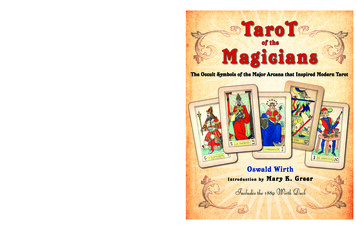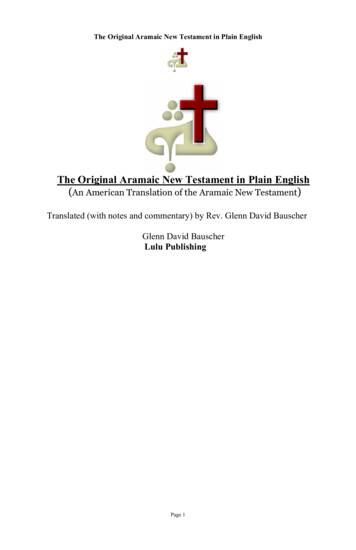
Transcription
WirthTaroTMagiciansof theIncludes the originalWirth 1889 Tarot Deck!Swiss occultist, artist, author, and student of Eliphas Levi, Oswald Wirth first publishedTarot of the Magicians in Paris in 1927. It was not until 1985 that Weiser published the first,and only, English translation of this book. Back in print with a new introduction by Tarotscholar and bestselling author Mary K. Greer, this edition includes full-color pull-out cardsreproducing Wirth’s 1889 Tarot deck.of theI N T H I S I M P O RTA N T TA ROT W O R K O F T H E M A J O R A RC A N A , Wirth combinesthe imagery and symbolism from Alchemy, Freemasonry, Rosicrucianism, and the magicalheritage of Egypt and Chaldea and explores the astronomical (rather than strictly zodiacal)associations for the Major Arcana cards.Magicians“Ultimately, for Wirth, the Tarot tells us where we came from,what we are, and where we are going (past, present, future).”—Mary K. Greer,from the introductionOswald Wirth (1860–1943) was a Swiss occultist, artist, and author. He was a student ofEliphas Levi and was mentored by Stanislas de Guaita.Mary K. Greer is an author and teacher and the Grandmaster of the American TarotAssociation. She is the founder and director of the learning center T.A.R.O.T. (Tools andRites of Transformation) as well as the author of several books, including 21 Ways to Reada Tarot Card and Who Are You in the Tarot? Visit her at: www.marygreer.wordpress.com.ISBN: 978-1-57863-531-3781578635313Oswald WirthIntroduction byMary K. GreerIncludes the 1889 Wirth DeckU.S. 24.955 2 4 9 59The Occult Symbols of the Major Arcana that Inspired Modern TarotTaroT“To make the Tarot speak is our objective, but the arcana only speak tothose who have learned to understand them.”—Oswald Wirth
This published in 2012 by Red Wheel/Weiser, llcWith offices at:665 Third Street, Suite 400San Francisco, CA 94107www.redwheelweiser.comFirst published in English in 1985 by Samuel Weiser, Inc.First published in Paris in 1927 under the original title:Le Tarot, des Imagiers du Moyen AgeCopyright 2012 by Red Wheel/Weiser llcAll rights reserved. No part of this publication may be reproduced or transmitted in anyform or by any means, electronic or mechanical, including photocopying, recording, orby any information storage and retrieval system, without permission in writing fromRed Wheel/Weiser, llc. Reviewers may quote brief passages.ISBN: 978-1-57863-531-3Library of Congress Cataloging-in-Publication Data available upon requestCover design by Jim WarnerInterior by Kathryn Sky-PeckPrinted in the United States of AmericaMAL10 98 7 6 5 4 3 2 1
ContentsIntroduction by Mary K. Greer . . . . . . . . . . . . . . . . . . . . . . . . . . . . . . . . . . viiAuthor's Preface . . . . . . . . . . . . . . . . . . . . . . . . . . . . . . . . . . . . . . . . . . . . . xviiAuthor's Introduction . . . . . . . . . . . . . . . . . . . . . . . . . . . . . . . . . . . . . . . . xxiiiPART ONE:The Tarot1. The Origins of the Tarot . . . . . . . . . . . . . . . . . . . . . . . . . . . . . . . . . . . . . . 32. Signs Revealing the Secrets of the Tarot . . . . . . . . . . . . . . . . . . . . . . . . . . 113. The Kabbalistic Tarot . . . . . . . . . . . . . . . . . . . . . . . . . . . . . . . . . . . . . . . 254. The Astronomical Tarot . . . . . . . . . . . . . . . . . . . . . . . . . . . . . . . . . . . . . . 355. Notions of Symbolism: Forms and Colours. . . . . . . . . . . . . . . . . . . . . . . 436. The Tarot and the Hebrew Alphabet . . . . . . . . . . . . . . . . . . . . . . . . . . . . 53PART TWO:The Symbolism of the Twenty-Two Keys to theSecret Knowledge of the Middle AgesThe Magician (1) . . . . . . . . . . . . . . . . . . . . . . . . . . . . . . . . . . . . . 61The Priestess (1i). . . . . . . . . . . . . . . . . . . . . . . . . . . . . . . . . . . . . . 64The Empress (1ii) . . . . . . . . . . . . . . . . . . . . . . . . . . . . . . . . . . . . . 67The Emperor (1v). . . . . . . . . . . . . . . . . . . . . . . . . . . . . . . . . . . . . 70The Pope (v). . . . . . . . . . . . . . . . . . . . . . . . . . . . . . . . . . . . . . . . . 74The Lover (vi) . . . . . . . . . . . . . . . . . . . . . . . . . . . . . . . . . . . . . . . 79The Chariot (vii). . . . . . . . . . . . . . . . . . . . . . . . . . . . . . . . . . . . . 82Justice (viii). . . . . . . . . . . . . . . . . . . . . . . . . . . . . . . . . . . . . . . . . 87The Hermit (ix). . . . . . . . . . . . . . . . . . . . . . . . . . . . . . . . . . . . . . 91The Wheel of Fortune (x). . . . . . . . . . . . . . . . . . . . . . . . . . . . . . . . 95Strength (xi). . . . . . . . . . . . . . . . . . . . . . . . . . . . . . . . . . . . . . . . . 98
The Hanged Man (xii). . . . . . . . . . . . . . . . . . . . . . . . . . . . . . . . 101Death (xiii). . . . . . . . . . . . . . . . . . . . . . . . . . . . . . . . . . . . . . . . 105Temperance (xiv). . . . . . . . . . . . . . . . . . . . . . . . . . . . . . . . . . . . 109The Devil (xv). . . . . . . . . . . . . . . . . . . . . . . . . . . . . . . . . . . . . . 113The Tower (xvi). . . . . . . . . . . . . . . . . . . . . . . . . . . . . . . . . . . . . 119The Star (xvii). . . . . . . . . . . . . . . . . . . . . . . . . . . . . . . . . . . . . . 124The Moon (xviii). . . . . . . . . . . . . . . . . . . . . . . . . . . . . . . . . . . . 130The Sun (xix). . . . . . . . . . . . . . . . . . . . . . . . . . . . . . . . . . . . . . . 135Judgement (xx). . . . . . . . . . . . . . . . . . . . . . . . . . . . . . . . . . . . . . 139The World (xxi). . . . . . . . . . . . . . . . . . . . . . . . . . . . . . . . . . . . . 144The Fool (xxii). . . . . . . . . . . . . . . . . . . . . . . . . . . . . . . . . . . . . . 148PART THREE:Résumé and Recapitulation7. Cosmogonic Outline . . . . . . . . . . . . . . . . . . . . . . . . . . . . . . . . . . . . . . . 1538. The Programme of Initiation as Revealed by the Tarot . . . . . . . . . . . . . . 1619. The Tarot Seen in the Light of Hermetic Philosophy . . . . . . . . . . . . . . . 16510. The Masonic Harmonies in the Tarot . . . . . . . . . . . . . . . . . . . . . . . . . 16911. The Arcana Interpreted in Terms of Good and Bad . . . . . . . . . . . . . . . 173PART FOUR:The Tarot as Applied to Divination12. Imagination . . . . . . . . . . . . . . . . . . . . . . . . . . . . . . . . . . . . . . . . . . . . . 18113. The Art of Divination . . . . . . . . . . . . . . . . . . . . . . . . . . . . . . . . . . . . . 18314. The Instruments of Divination . . . . . . . . . . . . . . . . . . . . . . . . . . . . . . 18715. Consulting the Tarot . . . . . . . . . . . . . . . . . . . . . . . . . . . . . . . . . . . . . . 18916. Interpretation of the Oracle . . . . . . . . . . . . . . . . . . . . . . . . . . . . . . . . . 19117. An Example of Interpretation . . . . . . . . . . . . . . . . . . . . . . . . . . . . . . . 19318. The Reality of the Art of Divination . . . . . . . . . . . . . . . . . . . . . . . . . . 19719. Conclusion . . . . . . . . . . . . . . . . . . . . . . . . . . . . . . . . . . . . . . . . . . . . . 199Appendix . . . . . . . . . . . . . . . . . . . . . . . . . . . . . . . . . . . . . . . . . . . . . . . . . . 209References . . . . . . . . . . . . . . . . . . . . . . . . . . . . . . . . . . . . . . . . . . . . . . . . . . 224Wirth and Wirth-Inspired Decks . . . . . . . . . . . . . . . . . . . . . . . . . . . . . . . . . 227
To the Memory of Stanislas de Guaitab
Introduction by Mary K. GreerASwiss, an Italian, a Spaniard and a Dutch-Frenchman walked into abar . . . It sounds like the beginning of a joke, but in the artistic andmetaphysical melting pot of fin de siècle Paris this was a formula for acreative and volatile, indeed, alchemical mixture as profound in the esoteric worldas the symbolist and expressionist movements were in the art and literary world.In 1888, the same year as the birth of England’s Hermetic Order of the GoldenDawn, Oswald Wirth joined Stanislas de Guaita, Papus, and Joséphin Péladanin founding the Ordre Kabbalistique de la Rose-Croix (“Kabbalistic Order of theRosy Cross”). The following year Wirth, under the direction of de Guaita, createda landmark Major Arcana Tarot deck that has been reproduced here for the firsttime since 1889 in a form that you can cut out to make your own deck.The Manand theDeckJoseph Paul Oswald Wirth was born on August 5, 1860 (d. 1943), around 9 a.m.in Brienz, near Bern, Switzerland to Alsatian parents. His father was a painter andOswald assisted him at his work. Around 1880 he came to Paris, served briefly inthe army, tried working as an accountant, joined the Freemasons, and took up thestudy of hypnotism, magnetic healing and occultism. He soon fell under the swayof the wealthy Italian nobleman, Stanislas de Guaita (1861–1897), who, at 26, wasa year younger, and already a well-known poet and author in French esoteric circles.Wirth became de Guaita’s close friend and personal secretary, beginning a nearlytwo year journey that would culminate in the Tarot deck, Les 22 Arcanes du TarotKabbalistique, originally published by Georges Poirel in an edition of 350 copies.A hundred years earlier, in 1781, Antoine Court de Gébelin (1719–1784)announced in volume eight of his encyclopedia, Le Monde Primitif, that thevii
Tarot, formerly seen as a card game, came from Egypt and portrayed ancientoccult mysteries. Eight years after that, Jean-Baptiste Alliette (1738–1791), underthe nom de plume Etteilla, published the first specifically occult deck, extensivelymodified to carry out the Egyptian and creation motifs described by de Gébelin.De Guaita didn’t think much of Etteilla’s deck. He felt that the true occultmysteries were already inherent in the traditional French Tarot de Marseille. So,with Wirth as the artist, they designed the 22 Arcana of the Kabbalistic Tarot,adding esoteric symbolism to the Marseille model. Their deck would be the firstto depict the Kabbalistic correspondences and magical philosophy of the greatFrench magician, Éliphas Lévi (Alphonse Louis Constant, 1804–75). Based ona seminal book on the Kabbalah, the Sepher Yetzirah, Lévi linked the Hebrewnumbers, letters and astrology to the Tarot. Although Lévi had died when deGuaita and Wirth were still youths, many of his unpublished papers were obtainedby de Guaita for his extensive esoteric library.The Wirth Tarot illustrated the 1889 edition of Le Tarot des Bohémiens byPapus (Gérard Encausse, 1865–1916), which also contained an essay by Wirth.As jealous animosity developed between them, Papus decided to create his ownoriginal Tarot card designs, illustrated by the talented young artist Jean-GabrielGoulinat (1883-1972), which he used in his 1909 book Tarot Divinatoire and inthe 1911 reprint of Le Tarot des Bohémiens.Not only were there tensions within the order, but when Oswald Wirth andStanislas de Guaita infiltrated a rival occult church and published an exposédescribing it as a “Temple of Satan,” the Kabbalistic Order of the Rosy Cross founditself in the middle of a violent magical conflict that was known as “The War of theRoses.” The writer Joris Huysmans, in a novel and an article, charged de Guaitawith murdering the Abbé Boullan by occult means. De Guaita challenged him to aduel and Huysmans backed down. There were more duels that included a comedyof errors of misfired guns and collapsed carriages, culminating when Papus and thepublisher Jules Bois finally wounded each other with sabers (which didn’t stop themfrom later becoming friends). De Guaita died suddenly in 1897—some said of adrug overdose while others claimed it was the result of a demonic attack.After de Guaita’s death Oswald Wirth took a civil service job in a governmentlibrary and lived quietly with his widowed sister and his niece. He went on tobecome a major figure in French Freemasonry, promoting through books andarticles an esoteric interpretation of the symbolism of their rituals and of the Tarotas a compendium of Masonic knowledge. Wirth clearly identified himself as theHermit in the Tarot, which in his deck is supposedly a self-portrait. His occultpseudonym, Diogène Gondeau, alludes to the ascetic Greek philosopher Diogenes,who is usually shown holding up a lamp in his search for “an honest man.”In 1926 Wirth designed a new version of his deck incorporating severalchanges and including metallic-gold ink and elaborate art nouveau bordersviiiTarot of the Magicians
containing thinly-disguised glyphs from the early Phoenician alphabet. A yearlater, he published the book you now hold in your hands, originally titled Le Tarotdes Imagiers du Moyen-Âge (“Tarot of the Medieval Image-Makers”) to share whathe had learned in forty years studying the Tarot. But, it wasn’t easy getting there.The T arot ChapelWirth tells us in his preface that he tragically lost the first manuscript of hisTarot opus, but was then given the opportunity for ‘uninterrupted meditation. . . stimulated by a Gothic background’ at a location ‘with one of the finestlandscapes in France.’ It was there that he was able to complete his secondversion. It was precisely for the unmatched beauty of the landscape that Americanheiress, Mary Wallace Shillito, built Le Château des Avenières on a hill top in thesouth of France. Mary Shillito was a devotee of Paris’ esoteric, literary and artisticsalons who married an engineer, occultist and amateur archeologist of Assyria andEgypt, Assan Farid Dina (1871-1928). Dina was well thought of in metaphysicalcircles, and together with his wife, they hosted gatherings of prominent occultistsincluding René Guénon, Papus, Paul Chacornac, René Schwaller de Lubicz andOswald Wirth.Built in the Gothic style (note Wirth’s description above), the Château(now a five-star hotel known for its breathtaking views) contains an even moreGothic chapel, completed in 1917. The walls are covered with enamel and goldmosaics depicting all the images of the Tarot Major Arcana. It is likely thatWirth retreated here to write his book. The chapel art and Dina’s own obsessionwith archaic alphabets must have inspired the revised art nouveau Tarot deckWirth published in 1926. French writer Alain Bocher speculates that the Tarotmosaics were actually designed by Wirth himself because of the unquestionablesimilarities. However, there are also images from the deck created by fellowOrder member, Papus with the artist Georges Goulinat. But, no matter whocopied whom, the chapel makes it clear by the way its images ascend into thevaulted ceiling, that Wirth’s own deck, rather than being a psychological orfortune-telling one was created as a moral and initiatory Tarot that describesthe apotheosis of human kind.S acred S ymbolsIn his preface, Wirth gives an eloquent description of the power of medievalsymbolism that he discovered upon following de Guaita’s instructions to restore thepurity of the Tarot. “We should learn to appreciate this masterpiece of the MiddleAges; worthy of our admiration to the same extent as are the Gothic cathedralsand philosophic Alchemy.” Sacred symbols that “put the esotericism of initiationinto picture forms” had more to do with the arts of the stone cutters of the greatIntroduction by Mary K. Greerix
cathedrals than with the more distant Egyptians. But, both were thought to containa deep, silent wisdom common to all cultures and kept alive in rituals like those ofthe Freemasons. These ideas are found in teachings called the Perennial Philosophy,Ancient Wisdom Tradition, the Secret Doctrine or Teachings of the Ages.Medieval consciousness experienced images as conduits for otherworldlyforces to effect the physical world. Statues and paintings were an invocation aswell as a remembrance of the forces depicted. In a sense, the Tarot remains as akind of last gasp of the medieval ideal of a cosmological order that continuallyreasserts itself in the lives of gods and men. There can be little doubt that in theminds of those who created the deck, it depicted relative positions in society,virtues and values, inevitable forces, and a triumphant end with which everyonecould be expected to essentially agree.Wirth’s original title, Le Tarot des Imagiers du Moyen Age (“Tarot of theMedieval Image-Makers”), alludes to human kind as constructive workers inthe eternal creative work of the Divine. The original word, imagier, is incrediblyrich as it can be translated as sculptor, artisan, stonecutter, illustrator orsymbolist. For Wirth, it referred to the operative craftsmen—architects andbuilders who made the temples and cathedrals—who would have belongedto a guild that initiated apprentices into the craft secrets that included sacredsymbolism. In a broader sense, each one of us partakes of the double nature ofartist-artisan, symbolist and builder shaping the rough stone into the perfectcube for a Temple, which is both the perfected self and a world in harmony withall its parts. Achievement of the “Great Work” of union with the Divine is onlya first step; it is to be followed by a commitment to remain earth-bound andwork toward the betterment of all society.Most of today’s Tarot readers come from a modern perspective that blendsJungian, Neopagan, New Thought, New Age, and earth-centered Eco-Spiritualismwith New Physics and a sprinkling of Theosophical concepts in a kind of quasipantheistic idea of the immanence of Spirit in all beings and in nature. It is importantto understand that Oswald Wirth came from a European world view that had onlyrecently emerged from the rationalist ideals of Enlightenment Humanism foundin such advocates of equality, social-responsibility and revolution as BenjaminFranklin and Thomas Paine. The occult Tarot blended this with a more esoterictranscendent deism espoused in Rosicrucianism and Freemasonry and in thepractice of theurgic magic. Major influences include Henry Cornelius Agrippa,Paracelsus, Jacob Böhme, Emanuel Swedenborg, Martinez de Pasquale andLouis Claude de Saint-Martin. The idea was to work with Nature but ultimatelytranscend it. The thread that runs through all this is the Perennial Philosophywith roots in Pythagorean numerology, Neoplatonism and Hermeticism, whichwas blended with Classical philosophy whose re-emergence had spearheadedthe Renaissance. By the seventeenth century a system of correspondences hadxTarot of the Magicians
emerged that included alchemy, astrology and Kabbalah—all suggesting thata direct knowledge of the nature of god (gnosis) is possible through a kind ofspiritual illumination.Transcendental Magicand theAstral LightÉliphas Lévi stood at the crossroads as the Romantic reaction to the Enlightenmentwound down into the spiritual aesthete of the Symbolists. He taught what hecalled “the Science of Transcendental Magic” in which he sought to reconcilemagic and religion. (Two of his books were translated into English by A.E. Waiteand a third by Aleister Crowley.) His was a metaphysical idealism, the key ofwhich he proclaimed could be found in a single book: a universal key, “whichis the summary of all sciences, which can resolve all problems by its infinitecombinations, which speaks by evoking thought, is the inspirer and moderator ofall possible conceptions, and the masterpiece perhaps of the human mind.” Thisbook, this “Great Arcanum of Transcendental Magic,” is, he tells us, the Tarot. (Theterms Major and Minor Arcana were coined by his follower, Paul Christian.)The English title of this book, Tarot of the Magicians, is found in ChapterSeven’s cosmogonic outline: “The god of Tarot is the Magician, the father of allthings, the eternal generator” who, as Wirth explains, symbolizes creative activityand will, the idea before conception. This idea directly addresses the magic oftranscendence that for Lévi and Wirth was accessed through the Astral Light, asort of etheric electromagnetism (aether, odic fluid, vril, orgone, prana, Qi andStar Wars’ The Force) that operates uniquely on each plane of consciousness: “Itis through this astral light that the signs and wonders of magic are mediated,”allowing the molding of energy through will into physical forms.For both Wirth and Lévi incarnation in the material world serves Spirit byforcing Spirit to free itself from the limitations of an illusion of separateness, bothfrom the Divine and from others. Nature becomes a kind of school in which weare to see through the illusion of separateness that matter imparts. Wirth followsLévi in seeing the Devil as the force which condenses astral light into a denseranimal magnetism—the instinct for physical survival—essential for the life ofthe body. As a radical force for self-preservation it sees each entity as separate andsees Nature and others for its own benefit—in a way, selfishly damming or shortcircuiting the free flow of energy. It is a person’s direction of this force by a purewill that is the secret to using its qualities for good. This is one of the great lessonsthat the Tarot teaches.Makingthe I nvisibleV isibleAlthough the Major Arcana-only Wirth Tarot has never become wildly popularin English-speaking countries, these twenty-two cards continue to intrigue andIntroduction by Mary K. Greerxi
inspire new expressions (see the list of decks at the end). Perhaps it is becauseWirth achieved what few deck designers have done: “a perfect unity of symbolismin which no element is unnecessary.” It is this quality that we find in the mosticonic decks, from the Renaissance Italian, to the Marseille, to the Rider-Waiteand Thoth. A fellow member of the Kabbalistic Order of the Rosy Cross, SârPéladan, wrote, “Making the invisible visible: that is the true purpose of art andits only reason for existence. . . . Art is a little piece of God within a painting. . . .If you create a perfect form, a soul will come and inhabit it.”This is true of the Wirth deck, which, like the other iconic decks, seems toendure through time. When the artist, Wirth, worked with the esotericist, deGuaita, depicting Éliphas Lévi’s vision of Tarot, he achieved something more thana projection of his own personality. Rather, it is a work edited to achieve not justbeauty but faithfulness to an intent that transcends the personal. Wirth drewthis deck many times over the years, with slight changes, to illustrate his articleson Masonic Tarot, and as simplified drawings for this book (the illustrationsused here were redrawn by Michel Simeon for a modern French edition). Theyculminated in his 1926 portfolio of gilded art nouveau Tarot plates.One other change should be noted. The title of the very important Appendixthat explains the book’s key symbols was rewritten in the 1966 Tchou edition. The1926 original translates as, “Some Indications on the Symbolism of the Pantacleswhich Accompany the Text.” It should read “pantacles” wherever the appendixtext previously read “pentacles.” This edition of the book has been corrected.A pantacle is any magical figure intended to produce results, a mental aid andprompt during magical workings. According to Éliphas Lévi, the pantacle is acomplete and perfect synthesis expressed by a single sign, which serves to focus allintellectual force into a glance, a recollection, a touch. It is a starting-point for theefficient projection of will. By contrast, a pentacle (a pentagram within a circle) isthe preeminent or archetypal pantacle, representing the Microcosm. Wirth tellsus, “At the sign of a pantacle we ought to enter meditation and through ourselvesfind the all (pan), the world of thoughts to which it is related.”For T arot Newbies : H owtoReadthisBookTarot newcomers and those interested primarily in reading the cards may get boggeddown by the order in which this work is presented. I suggest the following plan:xii Read only the first part of Chapter One on the origins of Tarot (thereare some historical errors that are understandable for the time). Proceed directly to Part Two on the symbolism of the trumps, referringto the Appendix as needed. (Some familiarity with the myths of Isis/Osiris and of Ishtar/Gilgamesh helps.)Tarot of the Magicians
Next, study Part Four on the Tarot applied to divination. Also helpful is Chapter 11 in Part Three, as it summarizes cardinterpretations in terms of both good and bad characteristics. After this, read the book through from beginning to end. And thenread it again a decade or so later.Those who truly want to experience Oswald Wirth as their teacher and guidewill read this book in the order he intended. To get the most from the experience, layout your own cards in the patterns described in Part One using the cards includedin the back of this book or another Wirth-influenced or Marseille-style deck.(A list of Wirth-inspired decks can be found at the end of this introduction.)Following his reasoning is like being taken through an intricate and confusinglandscape by an experienced guide who points out key elements that will help youmake important connections when you later explore on your own.While his explanations are only one of many Tarot perspectives, theyeffectively synthesize the great occult and metaphysical ideas that coalesced inFrance in the late 19th and early 20th centuries. For English-speakers, it canbroaden and deepen our parochial Anglo-American Tarot view, shaped primarilyby the Hermetic Order of the Golden Dawn and New Thought authors, PaulFoster Case and Eden Gray.The Meditation PatternsFor Oswald Wirth, the underlying structure of the Tarot is revealed first by viewingthe twenty-two arcana in a circle, neatly solving the perennial problem of wherethe Fool goes. He then divides them into two rows of eleven cards that providematching pairs, which Wirth next groups into quaternities. Regarding the tworows, the first row (cards 1 through 11) is an active, masculine set expressingwhat we possess innately. The second row (cards 12 through 21 & 0) is a passive,feminine set that is receptive and susceptible to the cosmic forces that surroundus. It helps to think of these two sets as the grammatical active and passive voices.The difference is similar to that between “John throws the ball” and “The ball wasthrown at John.” We can see this distinction more clearly in the two cards of theLovers and the Star: The Lovers is about actively making a choice, and the Star isabout being at the effect of one’s destiny. This dual process forms the bedrock forWirth’s understanding of the Tarot. He firmly believed that anyone who studiesthese sets will eventually learn all they need to know about the Tarot and abouthumanity’s purpose within the cosmos.When laid out in two rows, the second row begins with the Hanged Man.For the Hermeticist or alchemist, this card, half-way through, marks theaccomplishment of the Great Work—but only within oneself. The rest of theIntroduction by Mary K. Greerxiii
cards show how the Divine works upon the Adept after he or she has completelysurrendered to that working.In both this book and in the short follow-up, Introduction to the Study ofTarot, Wirth gives directions for learning directly from the pairs, although thetechnique is couched in paradox. “The main secret is to put the characters together in pairs and listen totheir conversation.” “By their contrast with each other, you can learn to know them best.” “To make the Tarot speak is our objective, but the arcana only speak tothose who have learned to understand them.” “Words do not suffice for what we see, which is why they are mute.But, out of the need to communicate what is seen in reverie, both thepoet and prophet is born.”In order to demonstrate that the cards work at different levels for differentpurposes, Wirth surveys the cards several times: first, he describes the symbolismthat informs any reading of the cards, then a cosmological overview, followedby the path of Initiation, the work of an Hermetic or Alchemical Adept, andfinally the allegories of Freemasonry. Some cards have a totally opposite meaningat different levels, for instance the Moon card is about getting lost in deceptionand illusion at one level, but at another it is about recognizing the symbolic andallegorical truths in old myths, mysteries and superstitions.D ivinationDespite his many-layered approach, Wirth never loses sight of the practicalities ofmundane divination. When he first published his deck in 1889 Wirth tells us hewas prejudiced against divination. However, many friends asked him for readings,which he could not deny them, and they reported back on the incredible accuracyof what was revealed. After much experience he concluded that, “To divine is toimagine rightly,” and that we must educate and discipline the imagination tomake divination into a sacred art.“Divination is the mother of all our knowledges, all our philosophies andof all our religions. It is worthy of respect and deserves to be taken seriously. . . One must divine in order to understand and acquire the clairvoyanceof which the narrow rationalist in his blindness deprives himself. Thisrationalist runs the risk of assuming the heavy gait of a learned beast.”His spread, which takes the form of a case being tried in court, is as iconicin France as the Celtic Cross Spread is in the English-speaking Tarot world. It Tarot of the Magicians
provides a perfect opportunity to listen to the cards converse as the prosecutingand defense attorneys argue their case and the judge evaluates their pleas.Ultimately, for Wirth, the Tarot tells us where we came from, what we are,and where we are going (past, present, future). The purpose is to regain Paradise,but in a Universal Regeneration in which, ultimately, all humans come as closeas nature will allow to Divine Perfection. We humans become artists in order tocomplete a Divine Work that brings order to human chaos. “We become FreeArtists, Free Builders, Freemasons, carrying out the plan of the Supreme Architectvia the law of life which is that of creative work.”Mary K. GreerMarch, 2012Introduction by Mary K. Greerxv
Author's PrefaceIndulging as I was
viii Tarot of the Magicians Tarot, formerly seen as a card game, came from Egypt and portrayed ancient occult mysteries. Eight years after that, Jean-Baptiste Alliette (1738-1791), under the nom de plume Etteilla, published the first specifically occult deck, extensively modified to carry out the Egyptian and creation motifs described by de .











